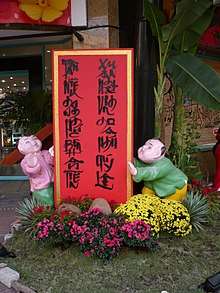Antithetical couplet
In Chinese poetry, a couplet (simplified Chinese: 对联; traditional Chinese: 對聯; pinyin: ![]()

Requirements
A couplet must adhere to the following rules:
- Both lines must have the same number of Chinese characters.
- The lexical category of each character must be the same as its corresponding character.
- The tone pattern of one line must be the inverse of the other. This generally means if one character is of the level (平) tone, its corresponding character in the other line must be of an oblique (仄) tone.
- The last character of the first line should be of an oblique tone, which forces the last character of the second line to be of a level tone.
- The meanings of the two lines must be related, with each pair of corresponding characters having related meanings too.
Example
Example of a couplet:
- 書山有路勤爲徑
- Tone pattern: 平平仄仄平平仄
- Pinyin: shū shān yǒu lù qín wéi jìng
- Translation: The mountain of books has one way and hard work serves as the path
- 學海無涯苦作舟
- Tone pattern: 仄仄平平仄仄平
- Pinyin: xué hǎi wú yá kǔ zuò zhōu
- Translation: The sea of learning has no end and effort makes the boat
| Bottom | Top | ||
|---|---|---|---|
| knowledge | 學 | 書 | book |
| sea | 海 | 山 | mountain |
| have not | 無 | 有 | have |
| border | 涯 | 路 | way |
| painstaking | 苦 | 勤 | diligence |
| makes | 作 | 爲 | becomes |
| boat | 舟 | 徑 | path |
好年好景好运气 good year good condition good fortune
多财多福多吉利 more wealth more happiness more lucky
心想事成百业兴 heart wish business success hundred industries flourishing
时来运到家昌盛 Chance come fortune arrive home prosperous
天增岁月人增寿 Heaven add years people gain ages
春满乾坤福满门 spring full universe happiness full house
宏图大展万事兴 grand prospect widely unfold millions things prosperous
富贵吉祥财源旺 rich honour lucky auspicious financial resource flourishing
人兴财旺平安宅 family growing finance flourishing peaceful house
福寿双全家常贵 happiness longevity both possessed house always honourable
旺犬旺财旺新年 vigorous dog flourishing finance prosperous new year
好年好景好运气 good year good condition good fortune
开工大吉 commencing work propitious
出入平安 travel safe and sound
History and usage
Originating during the Five Dynasties, and flourishing during the Ming and Qing dynasties in particular, couplets have a history of more than a thousand years and remain an enduring aspect of Chinese culture.
Often, couplets are written on red paper and stuck on walls. Sometimes, they are carved onto plaques of wood for a more permanent display.
Dueling couplets are a popular pastime with Chinese speakers,[1] a game of verbal and intellectual dexterity, wit and speed which shares some parallels with the dozens. A notable modern-day example occurs at the 7:24 point of the second segment of the satirical machinima War of Internet Addiction[2] (at 16:58 of the video's complete running time).
See also
Gallery






- Manuscripts in the Yunnan Nationalities Museum
 Vietnamese Couplet
Vietnamese Couplet